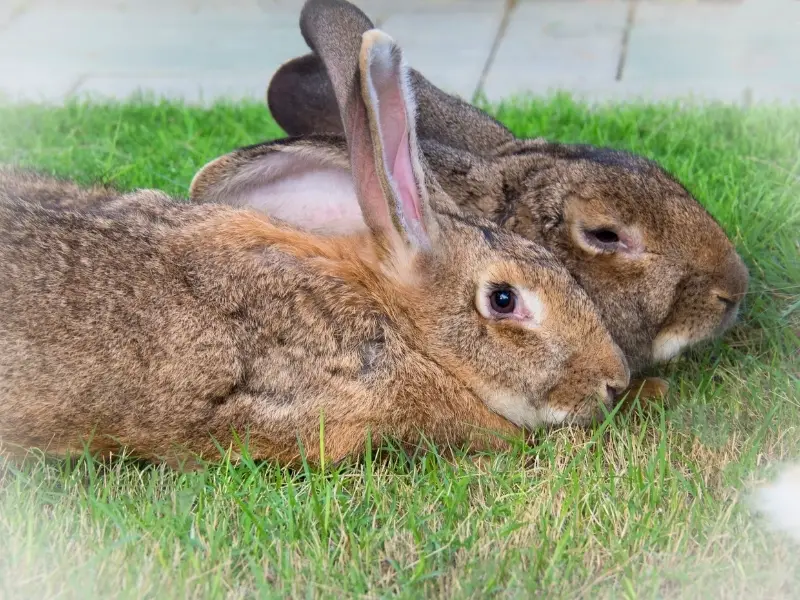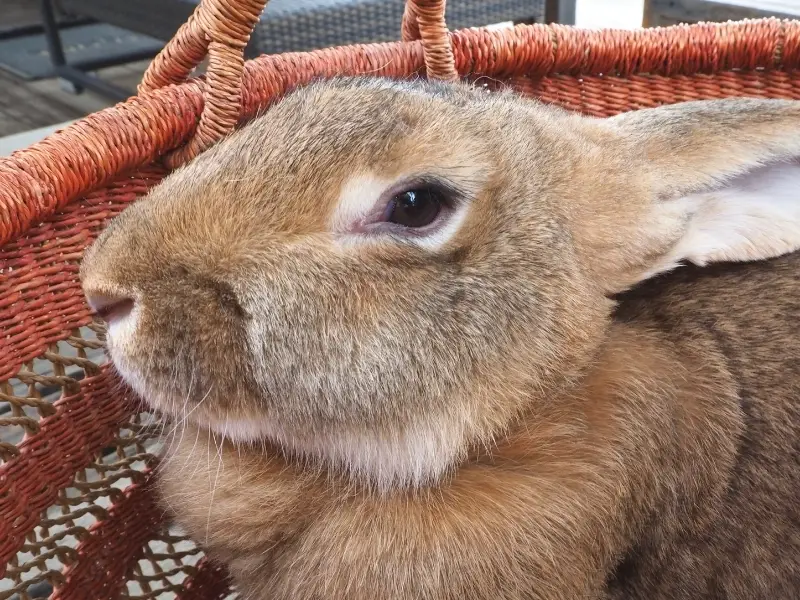The Flemish Giant rabbit is more than your average-sized bunny; it’s the largest rabbit breed in existence. Often bigger than a medium-sized dog, Flemish Giants are docile and friendly rabbits that are tolerant of handling.
But, do Flemish Giant rabbits make good pets? Despite their massive size, Flemish Giants make wonderful pets and companions. Sweet-natured, docile, and calm they like to be close to their people and tend to pick a special person. Friendly by nature Flemish Giants like to interact with their people and will need to spend some time indoors.
If you think that bigger is better and are looking for a docile and good-natured rabbit, the Flemish Giant bunny might be the best choice. Keep on reading to find out everything you need to know about this gentle giant!
What Is a Flemish Giant Rabbit?
The Flemish Giant rabbit is the largest breed of domestic rabbit (Oryctolagus cuniculus domesticus). Historically a utility breed bred for meat and fur, Flemish Giants are now popular pets and show rabbits.
Flemish Giant Rabbit History and Origin
The Flemish Giant is one of the oldest rabbit breeds. Originating in Flanders, Belgium these rabbits were bred as early as the 16th century. However, the earliest authentic record of this breed can be dated back to 1860.
The first standards for this breed were written in 1893. In the early 1980s, Flemish Giants were exported from England and Belgium to the United States to help improve the size of meat rabbits.
The Flemish Giant received little to no attention till 1910 when they started appearing at small livestock shows all over the USA. After that the breed’s popularity began to soar, making the Flemish Giants one of the most popular pet and show rabbits today.
This breed is promoted by the National Federation of Flemish Giant rabbit breeders which was founded in 1915. The Flemish Giant rabbit is recognized by the American Rabbit Breeders Association and is often seen at rabbit shows.
Flemish Giant Rabbit Characteristics

Due to their massive size, you’ll hardly confuse a Flemish Giant rabbit for any other breed. In fact, some Flemish Giants are so large that they grow as big as a medium-sized dog!
They have long muscular bodies with a heavy bone structure and broad hindquarters. Males have large and broadheads, and female rabbits may have a pronounced dewlap under their chins.
Size, Weight, Shape
The Flemish Giant rabbit is on average 2.5 feet long and weighs around 15 pounds. However, there is no maximum weight for Flemish Giant rabbits and the biggest specimens can weigh over 20 pounds. They are considered a semi arch breed since their spine has a noticeable but not severe arch.
Interestingly, the record for the largest rabbit in the world is currently held by a Flemish Giant who measured 4 feet and 3 inches long (source).
Colors
The Flemish Giant rabbit has a short, dense, and glossy coat that rolls back to its original position when stroked from hindquarters to the head.
The American Rabbit Breeders Association recognizes seven different color variations for this breed. They include black, blue, fawn, light gray, steel gray, sandy, and white.
Lifespan
Flemish Giant rabbits, on average, live from five to 10 years. If you decide to welcome this large bunny into your home, make sure that you’ll be able to care for it properly for many years to come.
Temperament
Nicknamed the gentle giant, this large bunny tends to be calm, docile, and sweet-natured. While individual temperaments can vary, most Flemish Giants are tolerant of handling and extremely patient.
This makes them a great pet for children who know how to interact and handle a rabbit properly. Despite their tolerant nature, the Flemish Giant, like all other rabbits, can become fearful, and sometimes even aggressive if handled incorrectly.
Due to their larger frame and sheer mass, Flemish Giants require special attention when it comes to handling and alignment of their spine.
Like all other pet rabbits, the gentle giant can also become frightened and nervous which can lead to kicking, scratching, and biting. With that being said, you should pay close attention when handling your Flemish Giant rabbit since they are large and strong enough to cause serious injuries when they feel scared.
Although they are naturally sociable, you should interact and get your Flemish Giant used to handle from a young age. This way you’ll ensure that their friendly personality really shines through.
Similar to other rabbit breeds, Flemish Giants can be trained to use litter boxes. Due to their large size, you’ll have to be creative and look for a large cat litter box or use a plastic pan or tray instead.
Flemish Giant Rabbit Care
As you would expect, the sheer size of a Flemish Giant rabbit means that they need a lot of space and that you’ll have to get creative with their housing. Most commercial rabbit cages and hutches are too small for a Flemish Giant so consider investing in a large and sturdy dog cage.
Alternatively, you may want to test your carpentry skills with a DIY project and build an outdoor hutch and a run for your rabbit. However, if you have enough space keep your pet rabbit indoors in a large pen or a rabbit-proof room.
Other things you should keep in mind include:
Coat
Flemish Giant rabbits have a short, dense, and glossy coat that doesn’t require a lot of grooming and should be brushed only once a week. Most Flemish Giants tend to enjoy brushing so grooming your pet might be a good opportunity for bonding.
Claws
Checking your rabbit’s claws and trimming them regularly is important for their overall health. Just like our nails, your rabbit’s claws grow continuously and you’ll have to trim or file them once a month or as necessary.
If you are afraid to do this at home, or can’t do it safely, take your Flemish Giant to your vet or a professional groomer.
Teeth
Flemish Giant rabbits, like all other rabbit breeds, have open rooted teeth that grow continuously during a rabbit’s life. This puts rabbits at risk of developing painful dental problems caused by outgrown teeth.
The best way to avoid these issues is by feeding your Flemish Giant rabbit a diet that consists mostly of hey. Chewing on hay will naturally file your rabbit’s teeth and prevent them from becoming ingrown.
To be on the safe side, you should check your pet rabbit’s teeth regularly and take them to the vet at the first sign of a problem to avoid more serious issues.
Health
Although they are generally healthy and have a fairly long lifespan, Flemish Giant rabbits are more at risk of developing certain health problems.
Pododermatitis, or sore hocks, are a common problem seen in Flemish Giants and other large rabbit breeds. Due to their large size, Flemish Giant rabbits put too much pressure on their feet which can lead to sore hocks. Especially if the bottom of their cage is made from wire mesh.
If left untreated, sore hocks can become very painful and require prolonged treatment. To prevent this condition from happening ensure that your rabbit has soft flooring that won’t cause injuries to their feet (source).
Arthritis and spinal spondylosis are also very common in older giant rabbits and are often seen in aging Flemish Giant rabbits.
If you notice that your pet rabbit is slowing down, shuffling on their hind legs, or unable to maintain personal hygiene they may have arthritis. These conditions can be managed with medication so take your rabbit to the vet for a full checkup.
Flystrike is another common issue that affects all rabbit breeds, although giant rabbit breeds, especially females are more affected. This is mainly because Flemish Giant does have a dewlap which prevents them from grooming their back end efficiently.
Due to this, it’s important to keep your Flemish Giant rabbit on the slim side and check their behind for urine and droppings regularly. When necessary, use pet wipes to clean your rabbit and maintain their hygiene.
Flemish Giant Rabbit Price
Expect to pay between $20 and $50 for a pet-quality Flemish Giant rabbit. But bear in mind that you may end up paying more depending on a breeder, the coat color of the rabbit, and your location.
If you are planning to buy a show-quality Flemish Giant rabbit be prepared to spend up to $300 or more. The price will depend on the breeder, the rabbit’s lineage, coat color, gender, and the area you live in.
Conclusion
If you believe that bigger is better, you’ll love everything the Flemish Giant rabbit has to offer! Nicknamed the gentle giant, the largest breed of rabbit makes a great family pet and companion thanks to its uniquely docile and calm nature.
Often growing as big as a medium-sized dog, the Flemish Giant rabbit makes a great pet and a show rabbit but is also a good meat and fur provider.
Related Articles:

